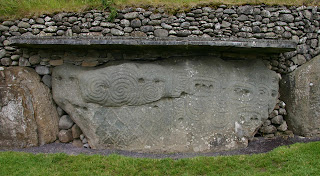
The second session was about seasonality and rock art and a number of presentations were really interesting, especially one from South Central Africa that linked the depicted signs to initiation rites through ethnographical examples. There were also wacky ones that tried to link the megalithic art of Irish passage tombs to the spawning of salmon. According to Robert Hensey the motif on the lower left are fish scales of salmon. Well, it didn't convince me at the least.
 During lunch break there was a plenary session about Tara and the new M3 motorway with many supporters (the minister, a local, and the excavation contract company) but also some archaeologist and students that accused them of falsifying data, bullying people and so on. Hopefully a landscape that is so important for the history of Ireland can be saved. But since money rules the world I fear we will lose this archaeologically and historically rich landscape around the hill of Tara.
During lunch break there was a plenary session about Tara and the new M3 motorway with many supporters (the minister, a local, and the excavation contract company) but also some archaeologist and students that accused them of falsifying data, bullying people and so on. Hopefully a landscape that is so important for the history of Ireland can be saved. But since money rules the world I fear we will lose this archaeologically and historically rich landscape around the hill of Tara. Got to http://www.savetara.com/ or http://www.tarawatch.org/ for more information. And listen to what Prof. George Eogan has to say about Tara and the M3:
http://www.youtube.com/watch?v=dk_9zkgIcxo
The last session was about rock art again and this one was really crazy. A lady tried to associate Palaeolithic cave art with mentally ill people, and a Professor from Toronto tried, with the help of a numerologist, to make an alphabet out of Palaeolithic abstract signs. The best part was how a museum in Portugal tried to bring rock art and people together and the contribution from George Nash who re-studied megalithic art and found a lot of up to now not detected motifs, from simple cupmarks to wonderfully pecked feet.
In the evening was the WAC party with -not only Guiness- but also a bronze caster

and a group of musicians:

You see, it was a long day again.
No comments:
Post a Comment